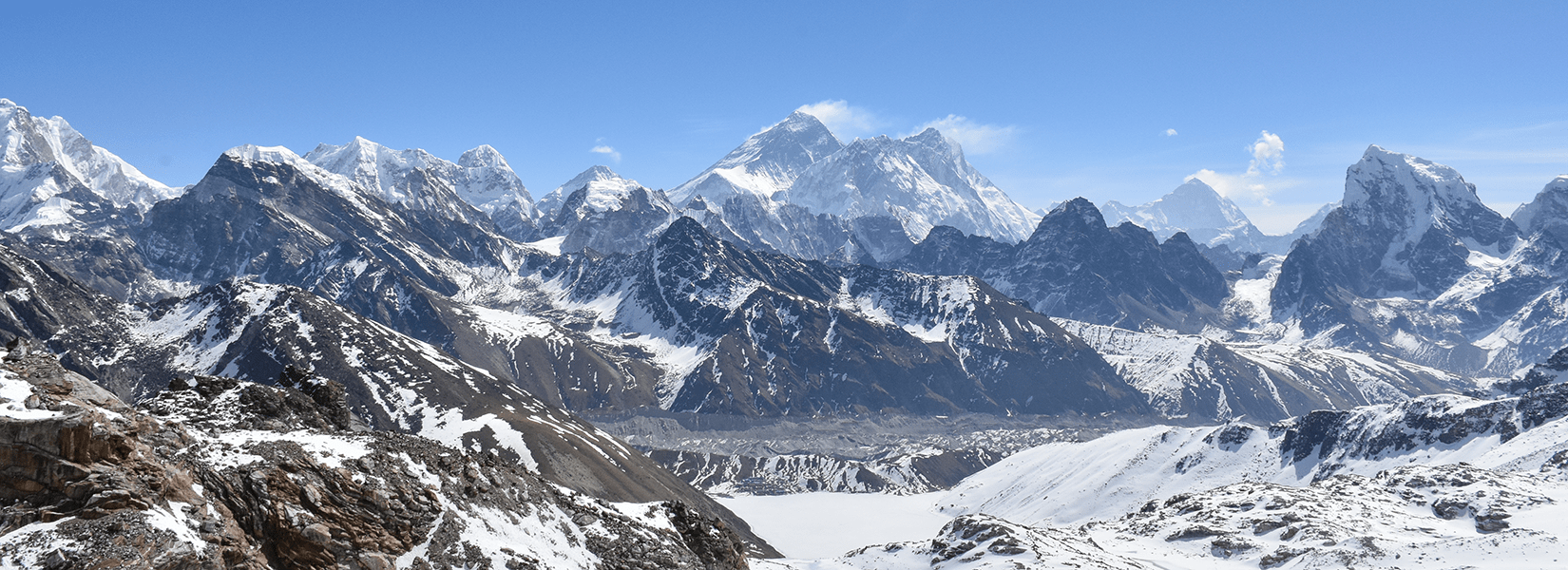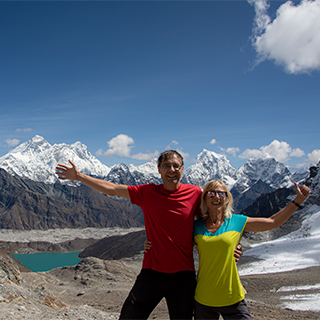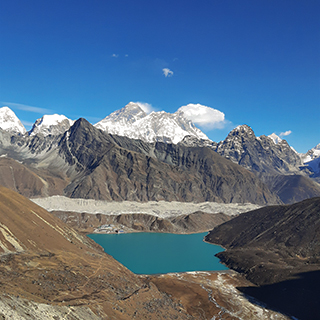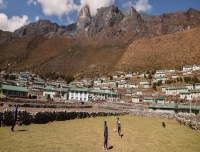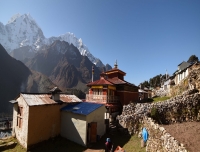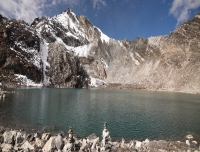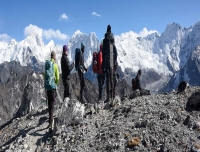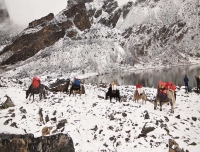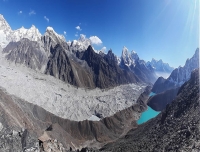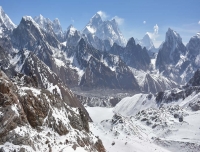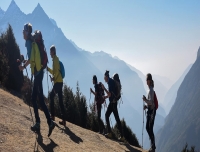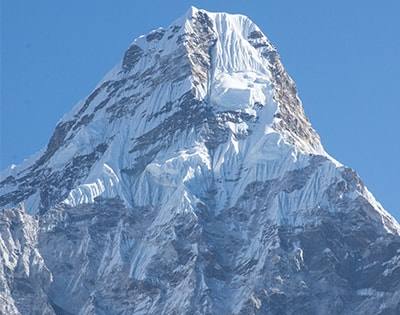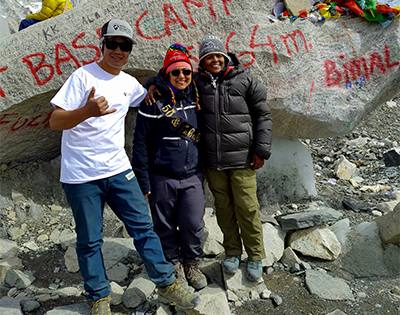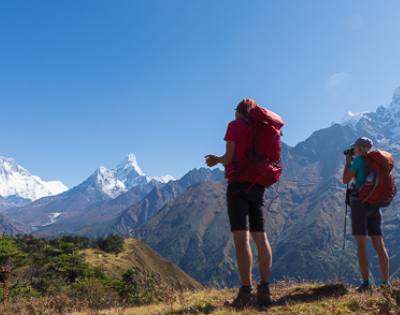- Read Reviews onTripadvisor
- Phone & WhatsApp Support+977 9851112535 (Chandra Shor)
Everest Three Passes Trek | 20 Days
Fact Information
- Duration
- 20 Days
- Destination
- Nepal
- Difficulty
- Very Strenuous
- Accommodation
- Hotel & Lodges
- Activity
- Trekking
- Transportation
- Tourist Bus, Car & Airplane
- Meals
- BLD (Breakfast, Lunch and Dinner)
- Max Person
- 18
- Min Person
- 2
- Best time
- September, October, November, April & May
About Trip
"An astonishing and rejuvenating aura of a natural lifetime experience"
The Everest Three Passes Trek is a challenging yet rewarding trek that takes hikers through the highest mountain passes in the Everest region of Nepal. Beginning in Lukla at 2,846 meters, the trek leads you through the famous Sherpa lands on off-beaten trails, moraines, and glaciers, culminating in the ascent of the three most challenging and picturesque passes: Khongma La Pass (5,535 meters), Cho La Pass, and Renjo La Pass. Along the way, you will also have the opportunity to visit the famous Everest Base Camp and Kalapatthar, which offer unparalleled views of Mount Everest, Mount Lhotse, Mount Makalu, Mount Ama Dablam, and the Khumbu glacier. The trek also includes visits to traditional Sherpa villages such as Namche Bazaar, Khumjung, Tengboche, Pangboche, Dingboche, and Thame, giving you a chance to learn about and immerse yourself in the unique culture and way of life of the Sherpa people. With its diverse scenery, including rhododendron, pine, and juniper forests, and an array of wildlife such as Himalayan goats and yaks, the Khumbu region is a must-see for any trekker or mountaineer.
The 3 pass EBC trek is a physically challenging but rewarding experience that requires a good level of physical fitness and the ability to acclimatize to the high altitude. The trek to the base camp typically takes about 18-20 days, depending on the route and pace of the trekker.
Discover the beauty of the 3 passes trek with the Himalayan Diamond Adventure team. Contact us for more information and experience our exceptional trip packaging service.
Trip Highlights
Mount Everest: One of the main draws of the trek is the opportunity to see the world's tallest mountain, Mount Everest, up close. You will have several opportunities to view the mountain from different angles and admire its grandeur.
High mountain passes: The three high mountain passes on the trek - Kongma La (5535m), Cho La (5420m), and Renjo La (5345m) - are among the highest in the world and offer stunning views of the surrounding peaks and valleys.
Sherpa culture: The trek takes you through the heart of the Solu-Khumbu region, home to the legendary Sherpa people. You will have the chance to visit traditional Sherpa villages, observe their daily life, and learn about their rich culture and history.
Scenic diversity: The trek offers a diverse range of landscapes, from lush forests to barren high-altitude terrain, and includes glaciers, moraines, and snow-capped peaks. You will also see rhododendron and juniper forests, glacial lakes, and rolling hills.
Monasteries and stupas: Along the way, you will encounter ancient monasteries and traditional stupas, some of which are over a thousand years old. These sacred sites offer a glimpse into the region's spiritual heritage and are fascinating to visit.
Sagarmatha National Park: The trek passes through the Sagarmatha National Park, a UNESCO World Heritage site that is home to some of the world's highest peaks and unique flora and fauna.
Outlined Itinerary
Day 01: Arrival in Kathmandu Airport 1,350m (4,429 ft), transfers to Hotel.
Day 02: Kathmandu to Lukla flight, and trek start to Phakding 2,610m (8,563 ft), 2.5hrs.
Day 03: Trek Phakding to Namche Bazaar 3,440m (11,286 ft), 5 hours.
Day 04: Hike to Everest view Hotel 3,870m (12,697 ft), for panorama view.
Day 05: Trek Namche to Tengboche Monastery 3,860m (12,664 ft), 5 hours.
Day 06: Trek to Dingboche through Pangboche Monastery 4,410m (14,468 ft), 5hrs.
Day 07: Hike to Nangkartshang viewpoint 5,083m (16,676 ft), 3 hours.
Day 08: Move Dingboche to Chhukung 4,730m (15,518 ft), 3 hours.
Day 09: Trek to Lobuche 4,910m (16,109 ft), over Khongma La 5,545m (18,192 ft), 9hrs.
Day 10: Trek Lobuche to Gorapse 5,171m (16,965 ft), 6 hours.
Day 11: Hike to EBC 5,400m (17,716 ft), trek to Dzonglha 4,830m (15,850 ft), 8-10 hrs.
Day 12: Cho La 5,375m (17,634 ft),Thangnak 4,700m (15,419 ft), Gokyo 4,800m(15,580 ft),10hrs.
Day 13: Hike to Gokyo Ri 5,357m (17,575 ft), for the panoramic Everest and Lakes views.
Day 14: Gokyo - Renjo La 5,360m (17,585 ft), Lungde, 8-9 hrs.
Day 15: Trek to Namche Bazaar 3,440m (11,280 ft), 8 to 9 hours.
Day 16: Namche Bazaar - Lukla 2,860m (9,175 ft), 7-8 hrs.
Day 17: Fly Lukla to Kathmandu 1,350m (4,429 ft), transfer to the hotel.
Day 18: Contingency days.
Day 19 Valley sightseeing.
Day 20: Finally, departure.
Detailed Itinerary
Day 01: Arrival in TIA, Kathmandu 1,350m (4,429 ft) and transfer to hotel.
Representatives from Himalayan Diamond Adventures will greet you upon your arrival at Tribhuvan International Airport in Kathmandu. You will be welcomed with a fresh flower garland, a traditional Nepali greeting, and then escorted to the hotel for bed and breakfast service. The drive from the airport to the hotel takes approximately 15 to 20 minutes, if there is no traffic jam on our way. After checking into the hotel, we will have a short refreshment meeting at the hotel. In the evening, the company will host a welcome dinner at a traditional Nepali restaurant, complete with a cultural dance performance, to celebrate the start of your trip. During the dinner, your guide will provide a brief overview of the schedule for the following day.
Accommodation: 3 to 5 Stars standard of hotel.
Transportation: Tourist bus or car.
Meals: Welcome Dinner, Breakfast, and including drinks.
Day 02: Kathmandu to Lukla flight, and trek from Lukla to Phakding 2,610 meters (8,563 ft), 2.5hrs.
Tomorrow morning, we will have an early morning drive to Ramechhap domestic airport for a 5- to 6-hour trip in a private vehicle, covering a distance of 135 kilometers from the hotel in Kathmandu to the Ramechhap airport. From there, we will take a short but exciting flight to Lukla Hillary airport, which is famous for its high altitude of 2,860 meters and its short and narrow runway.After arriving in Lukla, we will take a short break for final trip preparations. After about an hour, we will embark on our journey to Phakding. We will trek along a straightforward path, passing through beautiful Sherpa villages and religious sites, surrounded by stunning landscapes. After 2 and a half to 4 hours of comfortable trekking, covering a distance of 7.5 km (4.6 miles), we will reach Phakding, located at an altitude of 2,610 meters (8,563 feet).
Maximum Elevation: 2,860m (9,383 ft).
Trekking hours: 2.5 hrs, 200m descent, 50m ascent.
Accommodation: Lodge.
Meals: Lunch, Dinner, Breakfast with hot drinks.
Day 03: Trek Phakding to Namche Bazaar 3,440m (11,286 ft), 5 hours.
It's our second day in the mountains, so we are very excited to start the journey. Today, we will follow the small Dudh Koshi River valley, enjoying spectacular views. The trail will lead us through Sagarmatha National Park, passing many beautiful villages, restaurants, and guesthouses, as well as cultivated farmlands, waterfalls, and well-constructed suspension bridges over the Dudh Koshi River. As we trek through the village of Banker, we will have a stunning view of Kusum Kanguru (6,369 m) and Thamserku (6,623 m). After 2 to 3 hours of slightly uphill trekking, we will reach Sagarmatha National Park and present our permits. We should have an early hot lunch before leaving the last settlement of Jorsalle, as there are no places to eat hot meals until we reach Namche Bazaar. Our trail continues straight ahead to the confluence of the Dudh Koshi and Bhote Koshi rivers, following the Dudh Koshi River. Before starting
the tiring uphill trail, we will cross the famous Hillary Bridge, the highest bridge over the Dudh Koshi River. Today, we will trek for about 5 to 7 hours, covering a distance of 12.5 kilometers, with stunning landscapes throughout the journey from Phakding to Namche Bazar, at an altitude of 3,440 meters. This highly touristy location is called the Sherpa capital and is a fully facilitated place in the isolated area. There are luxurious hotels, banks, medical clinics, trekking shops, etc.
Elevation: 3,440 meters (11,286 ft).
Trekking hours: 5 hours, 1,000m ascent, 100m descent.
Accommodation: Lodge the attached bathroom.
Meals: B, L, D with hot drinks.
Day 04: Hike to Everest view Hotel 3,870m (12,697 ft), for panorama view.
Today is the acclimatization or rest day, allowing our bodies to adjust to the increasing altitude and decreasing temperature. To take advantage of this, we will explore the stunning Sherpa city and its surroundings. We will also hike to the Everest View Hotel, located at an altitude of 3,870 meters, for breathtaking views of the surrounding mountains, including Mount Everest, Mount Lhotse, Mount Ama Dablam, Mount Thamserku, Mount Taboche, and more. The Everest View Hotel is a major highlight of the tour, and offers spectacular panoramic views of the peaks. If we have enough time, we will visit Khumjung village, the Yeti Sculpture Monastery, and the Mountain Museum in Namche Bazaar.
Maximum elevation: 3,870m (12,697 ft).
Visit: Khumjung village and Hillary school.
Accommodation: Lodge.
Meals: Breakfast, Lunch, Dinner with hot drinks.
Day 05: Trek Namche to Tengboche Monastery 3,860m (12,664 ft), 5 hours.
Today, we're on day three of our mountain trek to Tengboche Monastery (altitude of 3,860 meters). The hike will take about 5-6 hours, covering 9.2 km from Namche, surrounded by stunning mountain views. The trail starts with a difficult path above Namche Bazar, but quickly becomes easier with breathtaking views of Mount Everest, Lhotse, Thamserku, and Amadablam. After a relaxing hike along the Kyangjuma valley and a break for lunch at Phunge Thanga, the trail becomes challenging from the Armi checkpoint area until Tengboche Monastery. The hike is difficult, but more enjoyable in April to May when rhododendron flowers bloom. This evening, we will visit the significant Tengboche Monastery.
Maximum Elevation: 3,860 meters (12,664 ft).
Trekking hours: 4 to 5 hours, 350m descent, 750m ascent.
Accommodation: Lodge.
Meals: Breakfast, Lunch, Dinner with hot drinks.
Day 06: Trek to Dingboche through Pangboche Monastery 4,410m (14,468 ft), 5hrs.
Today we will trek to Dengboche village, the last major settlement before EBC, in a 6-7 hour hike covering 6.5 miles (10.5 km). We will start with a slight descent through a forest of silver pines, birches, and rhododendrons with magnificent views of Everest, Lhotse, and Amadablam and cross the Imja Tse stream on a high suspension bridge. After crossing the bridge over the Imja river, the trail ascends slightly to Pangboche village with a breathtaking view of Mount Amadablam. We will stop for lunch at Somare. After lunch, we will continue on an off-the-beaten trail with a gradual ascent to Dingboche village, our final destination with stunning views of Lhotse and Lhotse Shar.
Maximum Elevation: 4,410 meters (14,468 ft).
Trekking hours: 4 to 5 hours, 70 descent, 580m ascent.
Accommodation: Lodge.
Meals: Breakfast, Lunch, Dinner with hot drinks.
Day 07: Hike to Nangkartshang viewpoint 5,083m (16,676 ft), 3 hours.
Today we will explore popular attractions near Dingboche for acclimatization and surplus views. Nangkartshang hill is an appropriate viewpoint for this. We will walk challenging moraines carefully and arrive at Nangkartshang hill (5083 meters). This hill offers incomparable views of Mount Makalu and Island peak. In addition to this, beauties, you will also get substantial views of Chukung valley, Imja-Tse glacier, the trail of Amphu Lapcha and Zongla valley, Cho La Pass etc. Return back to Dingboche lodge and stay there overnight.
Maximum Elevation: 5,083 meters (16,676 ft).
Hiking hours: 4 hours, 400m ascent.
Accommodation: Lodge.
Meals: Breakfast, Lunch, Dinner with hot drinks.
Day 08: Trek from Dingboche to Chhukung 4,730m (15,518 ft), 3 hours.
After breakfast in Dingboche, we will set towards Chhukung from Dingboche. The track travels along the Imja river valley providing a spectacular landscape of the surrounding Himalayas. We will pass through juniper trees and yak pastures as our trekking route ascends to stones and gravels. It will take us about 3 hours to arrive at the lodge in Chhukung. We can use the spare time by going on short hikes near Chhukung like Imja-Tse lake, Chhukung Ri etc. Chhukung Ri is particularly known for the best views of Island peak. Overnight stay in Chhukung.
Maximum elevation: 4,730 meters (15,518 ft).
Trekking hours: 3 hours, ascent 320m.
Accommodation: Lodge.
Meals: Lunch, Dinner, Breakfast with hot drinks.
Day 09: Trek to Lobuche 4,910m (16,109 ft), over Khongma La 5,535m (18,159 ft), 9hrs.
We'll start early and ascend to the Khongma La Pass, located at 5,535 meters and the highest of the three passes on this tour. The trail is steep and challenging with no tea houses or lodges along the way, so we'll need to carry enough water and lunch from Chhukum. The 5-hour trek passes through yak pastures with breathtaking views. Although the ascent is demanding, the 360-degree panoramic view from the top of Khongma La Pass is well worth it. After admiring the mountains, we'll descend steeply and cross the Khumbu glacier before reaching Lobuche.
Maximum elevation: 5,535m (18,159 ft).
Trekking duration: 8 hours, ascent 800m, descent 620m.
Accommodation: Lodge.
Meals: Breakfast, Lunch. Dinner with hot drinks.
Day 10: Trek Lobuche to Gorak shep 5,171m (16,965 ft), 6 hours.
From Lobuche, the trail leads towards the gravels or moraines along the Khumbu glacier, making the trek challenging due to high altitude and steep terrain. However, the stunning mountain views will accompany you throughout, replenishing your energy and enthusiasm. Gorak Shep is the last permanent settlement on the Everest Base Camp route. During your leisure time, you can rest in Gorak Shep or hike to Kalapatthar to catch the sunset views of Mount Everest. We'll spend the night at the Gorak Shep lodge.
Maximum Elevation: 5,550 meters (18,208 ft).
Hike: Kalapathar for the best Everest view.
Trekking Hours: 6 to 7 hours, 250m ascent, 50m descent.
Accommodation: Lodge.
Meals: B, L, D with hot drinks.
Day 11: Hike to EBC 5,400m (17,716 ft), trek to Dzonglha 4,830m (15,850 ft), 8-10 hrs.
We will hike to the base camp of the world's highest peak, Mount Everest, where we'll have the opportunity to meet climbers during the spring season. After reaching and celebrating our arrival at the Everest Base Camp, we'll return to Gorak shep for a hot meal. After a short rest, we'll continue our journey towards Dzongla, a journey that will be a long but rewarding one with breathtaking views
Maximum elevation: 4,830 meters (15,850 ft).
Trekking hours: 8 hours, ascent 330m, descent 450m.
Accommodation: Lodge.
Meals: Breakfast, Lunch, Dinner with hot drinks.
Day 12: Cho La 5,375m (17,634 ft), Thangnak 4,700m (15,419 ft), Gokyo 4,800m (15,580 ft),10hrs.
Our trekking route rises to a perpetual icy glacier field through a devoid field and then sabs rock underneath the gigantic rocky hills. The rockfalls and avalanches in the snowfall seasons can increase the difficulty. To avoid risk factors, trekkers should have to cross the pass early in the morning. After 3 hours of challenging trekking, we will reach the zenith of Cho La. As we trek higher, the view back gets even more captivating; the Cho La Lake begins to appear and the Ama Dablam in its pyramidal incarnation presides over a range of mountains on the south as Cholatse sores on the west.
The views from Cho La pass comprises mountains, cairns, prayer flags and so much more. After savoring the magnificent views from Cho La, we will trek down to Gokyo via Thang Nok.
Maximum elevation: Gokyo 4,800m (15,580 ft).
Trekking hours: 9-10 hours, 710m ascent, 590m descent.
Accommodation: Lodge.
Meals: Breakfast, Lunch, Dinner with hot drinks.
Day 13: Hike to Gokyo Ri 5,357m (17,575 ft), for the panoramic Everest and Lakes views.
We will hike to Gokyo Ri to witness the sunrise or sunset views. The sight of the sun's evening rays illuminating the world's highest peak with a breathtaking red glow is a memory worth cherishing. From Gokyo Ri (5,357 meters), you can see four 8,000-meter mountains: Cho Oyu (8,201 meters), Everest (8,848 meters), Lhotse (8,516 meters), and Makalu (8,463 meters), along with many other stunning peaks. Gokyo Ri is also the best viewpoint to admire the breathtakingly beautiful Gokyo Lakes (Dudh Pokhari) and Ngozumpa Glacier. The Gokyo Lakes are some of the most exotic and beautiful lakes located in the alpine region of Nepal.
Trekking hours: 3 hours, 570m ascent, 570 descents.
Accommodation: Lodge.
Meals: Breakfast, Lunch, Dinner with hot drinks.
Day 14: Gokyo - Renjo La 5,360m (17,585 ft), Lungden or Thame, 8-9 hrs.
A 4-hour climb up a challenging trail will take you to the summit of the picturesque Renjo La Pass from Gokyo Lake. The climb is tough, but the views of Everest, Lhotse, and Makalu are breathtaking. After crossing the pass, you'll descend a stone staircase, trek along the south bank of Angladumba Tsho lake, and follow an ancient Nepal and Tibet trading route to Thame. Although there's accommodation in Lungde, Thame offers better food and lodging options, so we'll head there.
Maximum elevation: 5,360 meters (17,585 ft).
Trekking hour: 8 hours, ascent 550m, descent 1520m.
Accommodation: Lodge.
Meals: Breakfast, Lunch, Dinner with hot drinks.
Day 15: Trek to Namche Bazaar 3,440m (11,280 ft), 8 to 9 hours.
We'll trek for approximately 2.5 hours from Thame to reach Namche Bazar. On the way, we'll stop at the Thame monastery. As we move away from the mountains, the green rhododendron forest will return to offer a lush and verdant backdrop for our trek.
Maximum elevation: 3,440 meters (11,280 ft).
Trekking duration: 2.5 hours.
Accommodation: Attached bathroom.
Meals: Breakfast, Lunch, Dinner with hot drinks.
Day 16: Namche Bazaar - Lukla 2,860m (9,175 ft), 7-8 hrs.
Today, we will retrace our steps back to the starting point of our journey in Lukla. This will take approximately 8 hours of trekking, mostly consisting of a descent, with some gradual uphill sections along the way. We will pass by the confluence of the Dudh Koshi River and Bhote Koshi River and many vibrant Sherpa villages. Today, we will hold a dinner party to celebrate the successful completion of our trip.
Elevation: 2,860 meters (9,383 ft).
Trekking hours: 8 hours, 960m descent, 250m ascent.
Accommodation: Lodge.
Meals: Breakfast/ Lunch/ Dinner with hot drinks.
Day 17: Fly to Ramechhap airport and drive back to Kathmandu hotel 1,350m (4,429 ft).
After an unforgettable journey, we'll fly to Ramechhap and drive back to Kathmandu. To celebrate the trip, we'll have a farewell dinner in this evening at a Nepali cultural restaurant, complete with traditional dance
Day 18: Contingency days.
This day is reserved to make up for our routine if we are lagging behind because of unfavourable weather, flight delay etc. We will continue our trek if we are right on schedule.
Day 19 Valley sightseeing.
We'll tour UNESCO World Heritage sites in the Kathmandu Valley, including Pashupatinath, Swayambhunath, Patan Durbar Square, and Boudhanath. Pashupatinath and Swayambhunath are religious shrines revered by Hindus and Buddhists. Boudhanath also showcases the religious and cultural diversity of Nepal. Additionally, we'll visit Bhaktapur Durbar Square and Patan Durbar Square, two royal palaces with historical significance and monuments.
Return back to the hotel and overnight stay.
Transportation: Tourist Bus.
Permits: Entry Permits of Patan, Bhaktapur, and Kathmandu.
Accommodation: 3 Stars standard of hotel.
Meals: Farewell Dinner and Breakfast.
Day 20: Finally, departure.
We'll drop you off at Tribhuvan International airport and say goodbye as you head home
Cost Details
What's included
- 1. Private vehicle for airport pickup and drop-off according to your itinerary.
- 2. A three-night stay in deluxe accommodation at Hotel Moonlight or Kathmandu Guest House in Thamel, Kathmandu, including breakfast as part of the package.
- 3. Private car transportation from Kathmandu to Ramechhap airport and back.
- 4. Flight fares for Ramechhap/Lukla/Ramechhap, including 15kg of luggage cargo.
- 5. A daily menu of your choice, providing three meals a day (breakfast, lunch, and dinner), along with fresh fruits. Hot drinks such as tea, coffee, ginger lemon tea, ginger lemon honey, hot chocolate, milk tea, milk coffee, and hot water are also available during the trip.
- 6. Comfortable teahouse accommodations during the trek, with private Western toilets in Lukla, Namche, Dingboche and Pheriche.
- 7. Inclusion of entry permits: Sagarmatha National Park fee and Pasang Lhamu Municipality fee.
- 8. Private car transportation for domestic and international airport transfers.
- 9. A one-day valley sightseeing tour including Pashupatinath, Boudhanath, and Swayambhunath, with all temple entry fees covered. A city guide and transportation are also provided.
- 10. An experienced, knowledgeable, and friendly English-speaking guide with a government license, including all expenses for salary, food, drinks, accommodation, transport, and insurance.
- 11. Assistance guide service, depending on the group size and requirements.
- 12. One strong and helpful porter assigned to every two members, equipped with proper gear including a Gore-Tex jacket/trousers, trekking shoes, woolen hat, woolen gloves, woolen socks, sunglasses, etc.
- 13. Insurance coverage for Nepalese staff, including emergency rescue evacuation by helicopter, hospitalization, medical treatment, and accidents.
- 14. Availability of medical supplies, including a first aid kit. Oximeter readings of pulse, oxygen saturation, and heart rate taken twice daily to monitor Altitude Mountain Sickness (AMS) symptoms.
- 15. Arrangement of Emergency Helicopter service, with the cost covered by your Travel Insurance company.
- 16. Complimentary items from the company: a duffle bag, map, and company T- shirt.
- 17. Hot bag services.
- 18. Inclusion of government taxes and official expenses.
- 19. Entry fees for UNESCO heritage sites.
- 20. Rental services available for down-filled jackets, sleeping bags, mini crampons, and trekking poles. A fee of $5 per day for laundry service and maintenance.
- 21. Welcome dinner and farewell dinner at Nepali cultural restaurants.
What's not included
- ❖ Personal trekking equipment and gears.
- ❖ Nepal entry visa fee.
- ❖ International airfare bill.
- ❖ Extra night accommodation in Kathmandu because of early arrival, late departure, early return from mountain (due to any reason) than the
- ❖ Meals while you stay in Kathmandu Hotel Lunch and Dinner.
- ❖ Your travel insurance policy should be covered rescue evacuation, medical treatment and accidental.
- ❖ Any entry fee for the temple or monastery.
- ❖ Donations or charity.
- ❖ Your personal expenses like; Hot shower, Laundry, Battery charging, telephone, WIFI, and shopping, etc.
- ❖ Alcoholic and non-alcoholic alcoholic hot and cold drinks.
- ❖ Tips for the guide, porter, and driver (tipping is expected)
Map
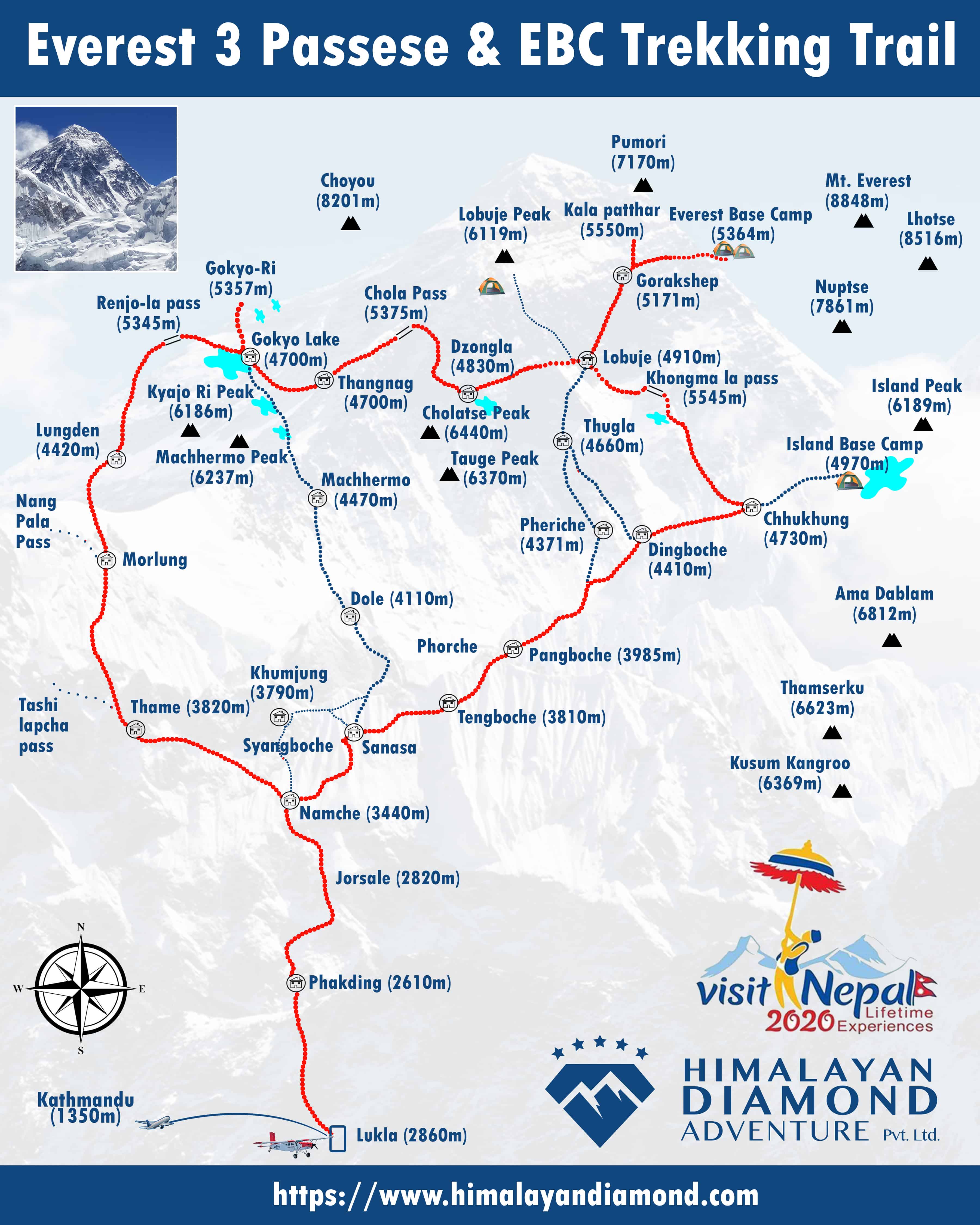
Client Review
Useful Info
What Essential Documents Do I Need To Bring With Me On Tour?
When going on a tour, it's important to bring essential documents to ensure a smooth and hassle-free trip. Here are some documents that we highly recommend you bring with you.
Passport: If you're traveling to a foreign country, you'll need a valid passport. Make sure to check the expiration date and renew it if necessary.
Visa: Depending on your destination, you may need a visa to enter the country. Check with the embassy or consulate of the country you're visiting to see if you need a visa.
Travel itinerary: It's always a good idea to have a printed copy of your travel itinerary, including flight and hotel reservations, tour bookings, and any other important travel plans.
Travel insurance: Consider purchasing travel insurance to protect yourself against unforeseen events, such as trip cancellations, medical emergencies, and lost or stolen luggage.
Health documents: If you're traveling to a country with specific health requirements, such as a yellow fever vaccination, make sure to bring the necessary health documents.
Driver's license: If you plan on driving while on tour, make sure to bring your driver's license.
Credit cards and cash: Bring enough cash and credit cards to cover your expenses while on tour.
Emergency contact information: Write down the contact information for someone you trust in case of an emergency. This could include a family member, friend, or employer.
It's always a good idea to make copies of all your important documents and keep them in a safe place in case the originals get lost or stolen. Additionally, you may want to consider using a travel document organizer to keep all your important documents organized and easily accessible.
If you are traveling to Nepal, then here are some essential documents you will need to have with you in order to ensure a smooth and hassle-free trip.
What Essential Documents Do I Need To Bring With Me For Everest Three Passes Tripr?
❖ Valid passport with at least 6 months validity and at least 2 blank visa pages
❖ Travel insurance policy document
❖ Photocopies of your passport's personal information page
❖ One or more recent passport-sized photos with a white background (1.5 inch x 1.5 inch)
❖ Completed and signed Nepal visa application form
❖ Proof of accommodation in Nepal (such as a hotel reservation or address)
❖ Valid return flight or travel ticket
❖ Proof of sufficient financial means, such as recent bank statements
❖ Mastercard, Visa, and some cash in USD
❖ Proof of payment of the Nepal visa fee
❖ To obtain a visa for Nepal, your passport must be valid for at least 6 months from the travel date and you must present either a completed COVID-19 vaccination certificate with QR code or a valid PCR test negative result taken within 72 hours prior to boarding.
How to apply for an online tourist visa to Nepal?
Visit the official website of the Department of Immigration of Nepal at https://www.immigration.gov.np/page/tourist-visa
1. Fill out the online application form with your personal information, including your name, date of birth, nationality, passport number, and intended travel dates.
2. Upload a recent passport-size photograph in JPEG or PNG format.
3. Pay the visa fee online using a credit card or debit card. The cost of the visa depends on the length of your stay in Nepal, but it typically ranges from $30 to $125.
4. Once you have submitted your application and payment, you will receive a confirmation email with a receipt and an application ID.
5. After your application has been processed, you will receive another email with a link to download your visa. You should print out the visa and carry it with you when you travel to Nepal. It's important to note that the online tourist visa is valid for multiple entries and is valid for 15, 30, or 90 days, depending on your length of stay. Also, be sure to apply for your visa well in advance of your travel date to allow time for processing.
What Type Of Insurance Should I Get?
It is essential for foreign travelers to secure insurance coverage while trekking or climbing in Nepal. Although trekking in Nepal is generally safe, travel insurance is compulsory for mountaineering activities in Nepal. The trip can pose physical challenges and hazards, particularly at high altitudes where altitude sickness is prevalent among trekkers and climbers, especially those who have not acclimatized properly. Physical injuries can also occur on mountain trails or during climbing activities, and in emergency situations, foreign trekkers or climbers may need to be rescued by helicopter and transported to hospitals in Kathmandu, which can be costly if the traveler does not have insurance coverage.
We strongly recommend purchasing a travel insurance package that covers high altitudes up to 5,500 meters, potential medical issues, natural disasters, personal accidents, emergency helicopter evacuation, loss or damage of personal belongings, and trip cancellations. The minimum recommended coverage amount is USD 100,000. There are many insurance companies that offer travel insurance services online. You should compare plans to find the one that best meets your needs.
What Are Some Popular And Highly Rated Travel Insurance Companies?
If you are in search of popular and highly-rated travel insurance companies, then we can recommend some based on positive feedback we have received from our previous travelers. It is here. [Company 1], [Company 2], [Company 3]............................
For Travelers from USA and CANADA........................
Online Global Health Insurance
Travelex
Insure My Trip.com (Online Insurance Aggregator)
Mondial Assistance
Access America
HCC Medical Insurance Services
Good Neighbor Insurance (International Health)
International Health
Insuremytrip dot com
MultiNational Underwriters
TIC Travel Insurance Coordinators Ltd
Travel Assist
TraveLite
For Travelers from England...................................
Specialty Group (UK) Limited
FirstAssist Services Limited
Harrison Beaumont
Buy cheap travel insurance
For Travellers from EUROPE and SLOVENIA...........................
Assistance CORIS
For Travellers from AUSTRALIA and NEW ZEALAND
Cover More Travel Insurance
CGU Insurance Limited
For Travellers from SOUTH AFRICA........................................
Travel insurance Consultants Pty. Ltd.
Weather Conditions & Temperature in Nepal
As Nepal's topography is divided into three geographical regions - Terai, Hills, and Mountains - each region experiences different temperatures during different seasons. Below is a tabular illustration of temperature changes throughout the different seasons in Nepal, which will allow you to better understand the changing weather conditions.
Seasons Minimum temperature (approx) Maximum temperature (approx) Weather Condition
Spring 4°C/ 39°F (Mountain) 20°C/ 68°F (Mountain) Moderate with occasional rain
Summer 12°C/ 53°F (Mountain) 25°C/ 77°F (Mountain) Extreme high with heavy rain
Autumn 3°C/ 37°F (Mountain) 18°C/ 64°F (Mountain) Moderate
Winter 10°C/ 50°F (Terai) -4°C/ 24°F (Mt.) 20°C/ 68°F (Terai) to 12°C/ 53°F (Mountain) Extreme low
What Is The Best Time To Trek In Nepal?
After a thorough analysis of all the seasons, it has been suggested that autumn is the best time of the year to trek in Nepal. The mild temperatures from September to November make the trekking experience more enjoyable. During this time of the year, trekking routes throughout the country are jam-packed with travelers from all around the world.
However, as mid-December is generally the holiday season in most countries, including the United States, there is a spike in the number of international tourists during early winter as well. Interestingly, to make the holiday season even more special, travel companies offer some of the best holiday destination packages during this time. So, be sure to take advantage of the best travel opportunities with the assistance of Himalayan Diamond Adventure.
Nonetheless, if you cannot make it in autumn, spring also allows for favorable conditions for trekking in Nepal. The warmer days and nights, lush plants and vegetation, and clear trekking trails during spring make the trek worthwhile. However, the downside is occasional rain and slightly higher temperatures in the lower elevations. All in all, after autumn, spring is the second-best time to trek in Nepal.
Best time to trek in Nepal:
Thousands of tourists visit Nepal every year to enjoy the picturesque nature and trek through the adventurous and diverse terrain. However, the best times to trek in Nepal are autumn (September to November) and spring (March to May). During these seasons, travelers are blessed with moderate temperatures and enjoyable weather conditions throughout the country.
As calm as it may seem, the challenging terrains of the Himalayas in Nepal can present trekkers with gruesome scenarios during harsh weather conditions. To avoid any unforeseen situations and to enjoy nature at its best, most trekkers prefer autumn for backpacking. However, it may not be the best time of the year to trek in Nepal for everyone. Some may prefer off-season trekking to avoid the crowds. Therefore, exploring the various seasons can help you choose a favorable time for trekking in Nepal based on your preferences.
Trekking Seasons in Nepal
Throughout the year, the landscape of Nepal experiences four seasons, each with its own uniqueness that brings significant changes to the natural environment. Below are some detailed insights into the four seasons in Nepal.
1. Spring Season (March-May)
Spring in Nepal lasts from March to May and is one of the preferred seasons for trekking throughout the country. During this time, the climate is moderate, with slightly higher temperatures reaching up to about 32°C (89°F) in the lower elevation regions and around 20°C (68°F) at higher altitudes. The sky is usually clear with mild days and occasional rain.
Spring brings a rejuvenation of nature. Flowers begin to blossom, trees become lusher with newly sprung leaves, and spring vegetation sprouts again. Likewise, the flora and fauna of the Himalayan terrain also resuscitate from the harsh winter. Overall, spring is considered a great time for trekking in Nepal due to the alluring freshness of nature.
2. Summer Season (June-August)
With the end of May, summer starts in Nepal and lasts from June to August, which is also the monsoon season in the country. During these months, the weather can be harsh, with scorching heat and heavy rain throughout the nation. The rising humidity and extreme hot weather conditions may restrict travelers from fully enjoying their trip.
Although the lower elevation regions experience harsh summers, the Himalayan terrains are not as brutal. In the mountain regions, temperatures can range from approximately 25°C to 12°C (77°F to 53°F). However, heavy rains can make trekking through rocky mountain terrain challenging, and the cloudy sky may obscure mountain views.
3. Autumn Season (September-November)
With the arrival of autumn from September to November, Nepal becomes a popular destination for trekking. During this season, the weather is usually pleasant with clear skies, moderate temperatures, and gentle sunshine throughout the day. However, early autumn may bring occasional light rainfall. As the season progresses into October and November, the monsoon season completely ends, and cooler weather conditions prevail.
Many people choose to trek to popular destinations such as Everest Base Camp, Annapurna Base Camp, and Poon Hill during this season. Additionally, autumn is festival season in Nepal, and visitors can witness major celebrations such as Dashain and Tihar, which provide an opportunity to experience Nepali culture and traditions. Many travel packages are available for the best treks in Nepal during this season, and our travel experts can help you plan your trip to align with the festival season.
4. Winter Season (December-February)
Winter, which lasts from December to February, is the harshest season for trekking in Nepal. As the temperature drops in December, nights become chilly, and temperatures can reach around 9°C (48°F) during the day and below 0°C (32°F) during the night in higher altitudes. During peak winter, many high passes and trekking routes in the mountains are covered with dense fog and snow, increasing the risk of unexpected accidents.
Because of the risks of unpleasant trekking conditions, most travelers avoid trekking in the Himalayan terrains during the winter season. Additionally, most expeditions and mountain climbing, including trekking in the Everest region, also come to a halt during the harsh winter. Overall, it may not be the best time to trek due to the challenges presented by the weather conditions.

